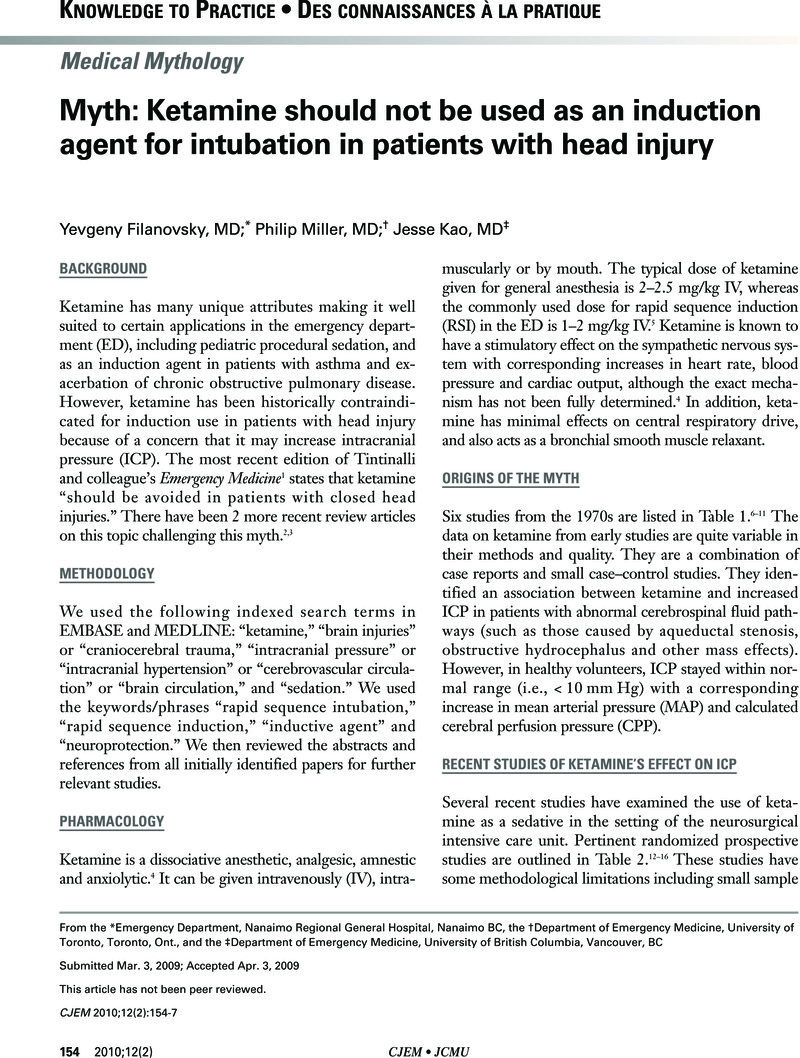Crossref Citations
This article has been cited by the following publications. This list is generated based on data provided by Crossref.
Griesdale, Donald E. G.
Henderson, William R.
and
Green, Robert S.
2011.
Airway Management in Critically Ill Patients.
Lung,
Vol. 189,
Issue. 3,
p.
181.
Kehoe, Anthony
Jones, A
Marcus, S
Nordmann, G
Pope, C
Reavley, P
and
Smith, C
2011.
Current Controversies in Military Pre-Hospital Critical Care.
Journal of the Royal Army Medical Corps,
Vol. 157,
Issue. Suppl 3,
p.
S305.
Sih, Kendra
Campbell, Samuel G
Talion, John M
Magee, Kirk
and
Zed, Peter J
2011.
Ketamine in Adult Emergency Medicine: Controversies and Recent Advances.
Annals of Pharmacotherapy,
Vol. 45,
Issue. 12,
p.
1525.
Moy, R.J.
and
Le Clerc, S.
2011.
Ketamine in prehospital analgesia and anaesthesia.
Trends in Anaesthesia and Critical Care,
Vol. 1,
Issue. 5-6,
p.
243.
Flower, Oliver
and
Hellings, Simon
2012.
Sedation in Traumatic Brain Injury.
Emergency Medicine International,
Vol. 2012,
Issue. ,
p.
1.
Scherzer, Daniel
Leder, Mark
and
Tobias, Joseph D.
2012.
Pro-Con Debate: Etomidate or Ketamine for Rapid Sequence Intubation in Pediatric Patients.
The Journal of Pediatric Pharmacology and Therapeutics,
Vol. 17,
Issue. 2,
p.
142.
Mayglothling, Julie
Duane, Therese M.
Gibbs, Michael
McCunn, Maureen
Legome, Eric
Eastman, Alexander L.
Whelan, James
and
Shah, Kaushal H.
2012.
Emergency tracheal intubation immediately following traumatic injury.
Journal of Trauma and Acute Care Surgery,
Vol. 73,
Issue. 5,
p.
S333.
Burns, Joseph D.
Green, Deborah M.
Metivier, Kristen
and
DeFusco, Christina
2012.
Intensive Care Management of Acute Ischemic Stroke.
Emergency Medicine Clinics of North America,
Vol. 30,
Issue. 3,
p.
713.
Cook, Tim
Behringer, Elizabeth Cordes
and
Benger, Jonathan
2012.
Airway management outside the operating room.
Current Opinion in Anaesthesiology,
Vol. 25,
Issue. 4,
p.
461.
Sachs, P.
and
Dauger, S.
2012.
Coma chez l'enfant.
EMC - Pédiatrie - Maladies infectieuses,
Vol. 7,
Issue. 1,
p.
1.
Sachs, P.
and
Dauger, S.
2012.
Coma en el niño.
EMC - Pediatría,
Vol. 47,
Issue. 2,
p.
1.
Marland, Susan
Ellerton, John
Andolfatto, Gary
Strapazzon, Giacomo
Thomassen, Oyvind
Brandner, Brigitta
Weatherall, Andrew
and
Paal, Peter
2013.
Ketamine: Use in Anesthesia.
CNS Neuroscience & Therapeutics,
Vol. 19,
Issue. 6,
p.
381.
van den Heuvel, Ingeborg
Wurmb, Thomas E.
Böttiger, Bernd W.
and
Bernhard, Michael
2013.
Pros and cons of etomidate – more discussion than evidence?.
Current Opinion in Anaesthesiology,
Vol. 26,
Issue. 4,
p.
404.
Michalczyk, Kathryn
Sullivan, Janice E.
and
Berkenbosch, John W.
2013.
Pretreatment With Midazolam Blunts the Rise in Intracranial Pressure Associated With Ketamine Sedation for Lumbar Puncture in Children.
Pediatric Critical Care Medicine,
Vol. 14,
Issue. 3,
p.
e149.
Price, Brian
Arthur, Annette O.
Brunko, Michael
Frantz, Pam
Dickson, Joshua O.
Judge, Tom
and
Thomas, Stephen H.
2013.
Hemodynamic consequences of ketamine vs etomidate for endotracheal intubation in the air medical setting.
The American Journal of Emergency Medicine,
Vol. 31,
Issue. 7,
p.
1124.
Caricato, Anselmo
Tersali, Alessandra
Pitoni, Sara
De Waure, Chiara
Sandroni, Claudio
Bocci, Maria Grazia
Annetta, Maria Giuseppina
Pennisi, Mariano Alberto
and
Antonelli, Massimo
2013.
Racemic ketamine in adult head injury patients: use in endotracheal suctioning.
Critical Care,
Vol. 17,
Issue. 6,
Wang, Xin
Ding, Xibing
Tong, Yao
Zong, Jiaying
Zhao, Xiang
Ren, Hao
and
Li, Quan
2014.
Ketamine does not increase intracranial pressure compared with opioids: meta-analysis of randomized controlled trials.
Journal of Anesthesia,
Vol. 28,
Issue. 6,
p.
821.
Wheeler, Derek S.
2014.
Pediatric Critical Care Medicine.
p.
299.
Argent, Andrew C.
and
Figaji, Anthony
2014.
Pediatric Critical Care Medicine.
p.
569.
Sikorski, Robert A.
Koerner, A. Ken
Fouche-Weber, L. Yvette
and
Galvagno, Samuel M.
2014.
Choice of General Anesthetics for Trauma Patients.
Current Anesthesiology Reports,
Vol. 4,
Issue. 3,
p.
225.


